SKODA CITIGO 2014 1.G Service Manual
Manufacturer: SKODA, Model Year: 2014, Model line: CITIGO, Model: SKODA CITIGO 2014 1.GPages: 164, PDF Size: 12.08 MB
Page 41 of 164

Engine performance checkRead and observe
on page 34 first.
If the indicator light
illuminates , there is a fault in the engine control. The
system allows the vehicle to run in emergency mode.
Seek assistance from a specialist garage immediately.
Airbag system
Read and observe
on page 34 first.
Monitoring the airbag system
If the warning light does not go out for some seconds after the ignition has
been switched on or illuminates while you are driving, there is a fault in the
system »
. This also applies if the warning light does not come on when the
ignition is switched on.
The operational capability of the airbag system is monitored electronically, in-
cluding when one of the airbags is switched off.
One of the airbags or a belt tensioner has been disabled by the diagnostic
tool
› The warning light
illuminates for approx. 4 seconds after switching on the
ignition and then flashes again for approx. 12 seconds afterwards.
The front passenger airbag has been disabled with the key switch
› The warning light
illuminates for a few seconds when the ignition is
switched on;
› The deactivated airbag is indicated by the illumination of the warning light
in the middle of the dash panel
» page 18, Deactivating
the front passenger airbag .
WARNINGWhen a fault in the airbag system occurs, there is a risk of the system not
being triggered in the event of an accident. Therefore, this must be
checked immediately by a specialized garage.
Handbrake - automatic transmission
Read and observe
on page 34 first.
If the warning light
illuminates or blinks, engage the handbrake.
Further information » page 80, Automated transmission .
Brake pedal (automatic transmission)
Read and observe
on page 34 first.
If the warning light
illuminates , operate the brake pedal.
Further information » page 80, Automated transmission .
Turn signal system
Read and observe
on page 34 first.
Either the left or right
indicator light
flashes depending on the position of
the control lever.
If there is a fault in the turn signal system, the warning light flashes at twice
its normal rate.
Switching off the hazard warning light system is switched on will cause all of
the turn signal lights as well as both warning lights to flash.
Cruise control system
Read and observe
on page 34 first.
The warning light
illuminates when the cruise control is active.
Main beam
Read and observe
on page 34 first.
The warning light
illuminates when the main beam or the headlight flasher
is operated.
/ Safety belt (belt status display) - rear seat
Read and observe
on page 34 first.
After switching on the ignition, illumination takes place in the display of the
instrument cluster for 30 s of the symbols or
.
38Using the system
Page 42 of 164
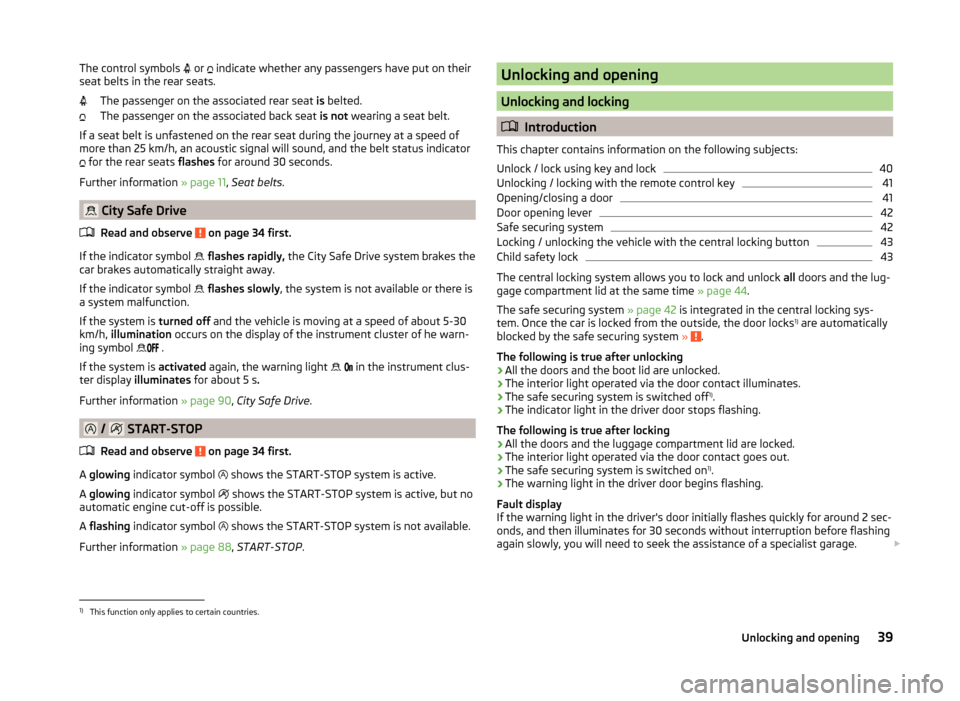
The control symbols or indicate whether any passengers have put on their
seat belts in the rear seats.
The passenger on the associated rear seat is belted.
The passenger on the associated back seat is not wearing a seat belt.
If a seat belt is unfastened on the rear seat during the journey at a speed of
more than 25 km/h, an acoustic signal will sound, and the belt status indicator
for the rear seats
flashes for around 30 seconds.
Further information » page 11, Seat belts .
City Safe Drive
Read and observe
on page 34 first.
If the indicator symbol
flashes rapidly, the City Safe Drive system brakes the
car brakes automatically straight away.
If the indicator symbol
flashes slowly , the system is not available or there is
a system malfunction.
If the system is turned off and the vehicle is moving at a speed of about 5-30
km/h, illumination occurs on the display of the instrument cluster of he warn-
ing symbol .
If the system is activated again, the warning light
in the instrument clus-
ter display illuminates for about 5 s .
Further information » page 90, City Safe Drive .
/ START-STOP
Read and observe
on page 34 first.
A glowing indicator symbol
shows the START-STOP system is active.
A glowing indicator symbol
shows the START-STOP system is active, but no
automatic engine cut-off is possible.
A flashing indicator symbol
shows the START-STOP system is not available.
Further information » page 88, START-STOP .
Unlocking and opening
Unlocking and locking
Introduction
This chapter contains information on the following subjects:
Unlock / lock using key and lock
40
Unlocking / locking with the remote control key
41
Opening/closing a door
41
Door opening lever
42
Safe securing system
42
Locking / unlocking the vehicle with the central locking button
43
Child safety lock
43
The central locking system allows you to lock and unlock all doors and the lug-
gage compartment lid at the same time » page 44.
The safe securing system » page 42 is integrated in the central locking sys-
tem. Once the car is locked from the outside, the door locks 1)
are automatically
blocked by the safe securing system »
.
The following is true after unlocking
› All the doors and the boot lid are unlocked.
› The interior light operated via the door contact illuminates.
› The safe securing system is switched off 1)
.
› The indicator light in the driver door stops flashing.
The following is true after locking
› All the doors and the luggage compartment lid are locked.
› The interior light operated via the door contact goes out.
› The safe securing system is switched on 1)
.
› The warning light in the driver door begins flashing.
Fault display
If the warning light in the driver's door initially flashes quickly for around 2 sec-
onds, and then illuminates for 30 seconds without interruption before flashing
again slowly, you will need to seek the assistance of a specialist garage.
1)
This function only applies to certain countries.
39Unlocking and opening
Page 43 of 164

Automatic locking and unlocking
All the doors and the luggage compartment lid are locked automatically once
the car reaches a speed of about 15 km/h.
If the ignition key is withdrawn, the car is then automatically unlocked again. It
is also possible for the driver to unlock the car by pressing the central locking
button.
The vehicle doors can be unlocked and opened at any time by pulling once on
the door opening lever.
Failure of the central locking
If the central locking system fails only the driver's door can be unlocked or
locked with the key. The other doors and the boot lid can be emergency locked
or unlocked.
› Emergency locking of the door
» page 133.
› Emergency unlocking of the luggage compartment lid
» page 134.WARNING■
Never leave the key in the vehicle when you exit the vehicle. Unauthor-
ized persons, such as children, for example, could lock the car, turn on the
ignition or start the engine - there is a danger of injury and accidents!■
When leaving the vehicle, never leave persons who are not completely in-
dependent, such as children, unattended in the vehicle. The children might,
for example, release the handbrake or take the vehicle out of gear. The ve-
hicle could then start to move – risk of injury and accidents! These individu-
als might also not be able to leave the vehicle on their own or to help
themselves. Can be fatal at very high or very low temperatures!
■
If the car is locked from the outside and the safelock system is switched
on, there must not be any person in the car as it is then not possible to
open either a door or a window from the inside. The locked doors make it
more difficult for rescuers to get into the vehicle in an emergency – risk to
life.
CAUTION
■ Each key contains electronic components; therefore it must be protected
against moisture and severe shocks.■
Keep the groove of the keys absolutely clean. Impurities (textile fibres, dust,
etc.) have a negative effect on the functionality of the locking cylinder and ig-
nition lock.
■
The battery must be replaced if the central locking does react to the remote
control at less than around 3 metres away » page 133.
■
When leaving the vehicle, always check if it is locked.■If the driver's door has been opened, the vehicle cannot be locked.
Note
In the event of an accident in which the airbags are deployed, the locked doors
are automatically unlocked in order to enable rescuers to gain access to the
vehicle.
Unlock / lock using key and lock
Fig. 24
Left side of the vehicle: Turning
the key for unlocking and locking
the vehicle
Read and observe and on page 40 first.
The key allows you to unlock and lock the vehicle via the lock cylinder in the driver's door.
Unlocking / locking the vehicle with the key » Fig. 24
Unlocking the vehicle
Locking the vehicle
40Using the system
Page 44 of 164
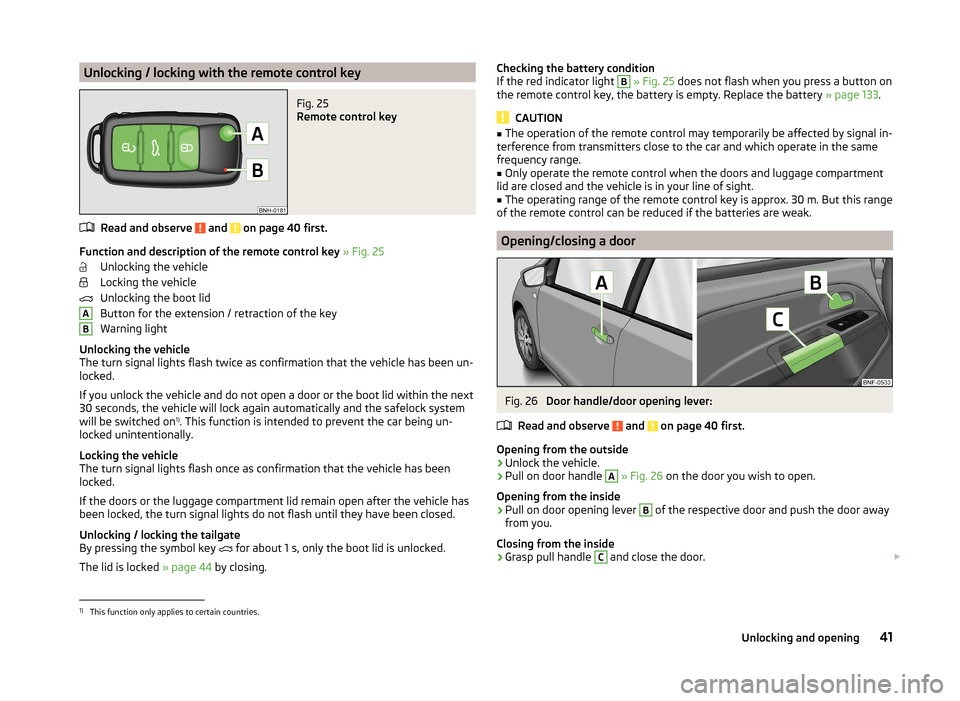
Unlocking / locking with the remote control keyFig. 25
Remote control key
Read and observe and on page 40 first.
Function and description of the remote control key » Fig. 25
Unlocking the vehicle
Locking the vehicle
Unlocking the boot lid
Button for the extension / retraction of the key
Warning light
Unlocking the vehicle
The turn signal lights flash twice as confirmation that the vehicle has been un-
locked.
If you unlock the vehicle and do not open a door or the boot lid within the next
30 seconds, the vehicle will lock again automatically and the safelock system
will be switched on 1)
. This function is intended to prevent the car being un-
locked unintentionally.
Locking the vehicle
The turn signal lights flash once as confirmation that the vehicle has been
locked.
If the doors or the luggage compartment lid remain open after the vehicle has
been locked, the turn signal lights do not flash until they have been closed.
Unlocking / locking the tailgate
By pressing the symbol key for about 1 s, only the boot lid is unlocked.
The lid is locked » page 44 by closing.
ABChecking the battery condition
If the red indicator light B » Fig. 25 does not flash when you press a button on
the remote control key, the battery is empty. Replace the battery » page 133.
CAUTION
■
The operation of the remote control may temporarily be affected by signal in-
terference from transmitters close to the car and which operate in the same
frequency range.■
Only operate the remote control when the doors and luggage compartment
lid are closed and the vehicle is in your line of sight.
■
The operating range of the remote control key is approx. 30 m. But this range
of the remote control can be reduced if the batteries are weak.
Opening/closing a door
Fig. 26
Door handle/door opening lever:
Read and observe
and on page 40 first.
Opening from the outside
›
Unlock the vehicle.
›
Pull on door handle
A
» Fig. 26 on the door you wish to open.
Opening from the inside
›
Pull on door opening lever
B
of the respective door and push the door away
from you.
Closing from the inside
›
Grasp pull handle
C
and close the door.
1)
This function only applies to certain countries.
41Unlocking and opening
Page 45 of 164
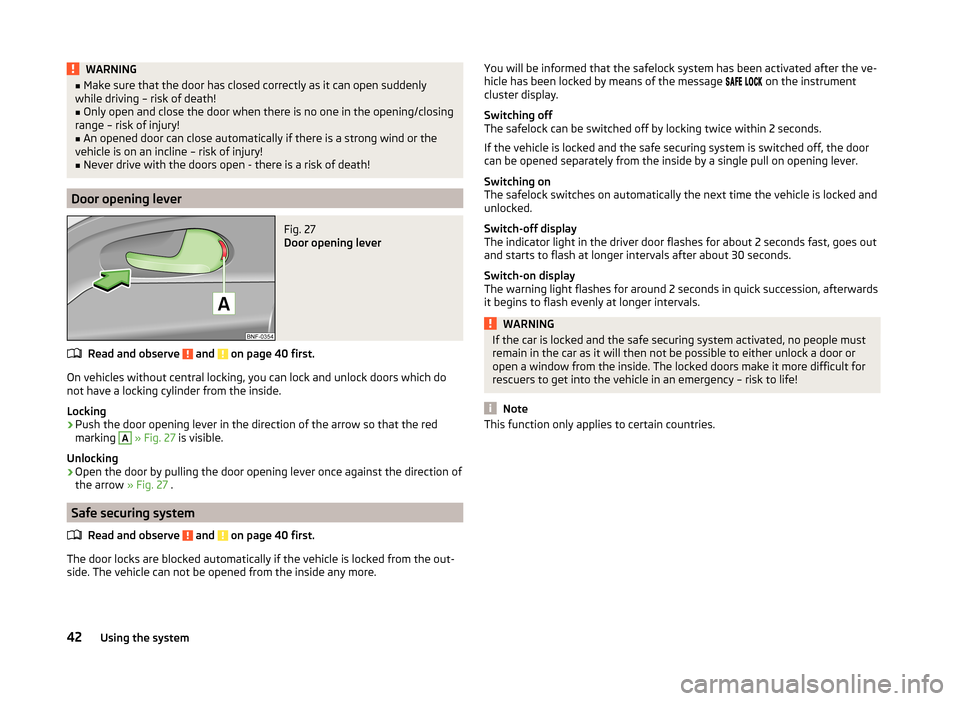
WARNING■Make sure that the door has closed correctly as it can open suddenly
while driving – risk of death!■
Only open and close the door when there is no one in the opening/closing
range – risk of injury!
■
An opened door can close automatically if there is a strong wind or the
vehicle is on an incline – risk of injury!
■
Never drive with the doors open - there is a risk of death!
Door opening lever
Fig. 27
Door opening lever
Read and observe and on page 40 first.
On vehicles without central locking, you can lock and unlock doors which do
not have a locking cylinder from the inside.
Locking
›
Push the door opening lever in the direction of the arrow so that the red
marking
A
» Fig. 27 is visible.
Unlocking
›
Open the door by pulling the door opening lever once against the direction of
the arrow » Fig. 27 .
Safe securing system
Read and observe
and on page 40 first.
The door locks are blocked automatically if the vehicle is locked from the out-side. The vehicle can not be opened from the inside any more.
You will be informed that the safelock system has been activated after the ve-
hicle has been locked by means of the message on the instrument
cluster display.
Switching off
The safelock can be switched off by locking twice within 2 seconds.
If the vehicle is locked and the safe securing system is switched off, the door
can be opened separately from the inside by a single pull on opening lever.
Switching on
The safelock switches on automatically the next time the vehicle is locked and
unlocked.
Switch-off display
The indicator light in the driver door flashes for about 2 seconds fast, goes out
and starts to flash at longer intervals after about 30 seconds.
Switch-on display
The warning light flashes for around 2 seconds in quick succession, afterwards
it begins to flash evenly at longer intervals.WARNINGIf the car is locked and the safe securing system activated, no people must
remain in the car as it will then not be possible to either unlock a door or
open a window from the inside. The locked doors make it more difficult for
rescuers to get into the vehicle in an emergency – risk to life!
Note
This function only applies to certain countries.42Using the system
Page 46 of 164
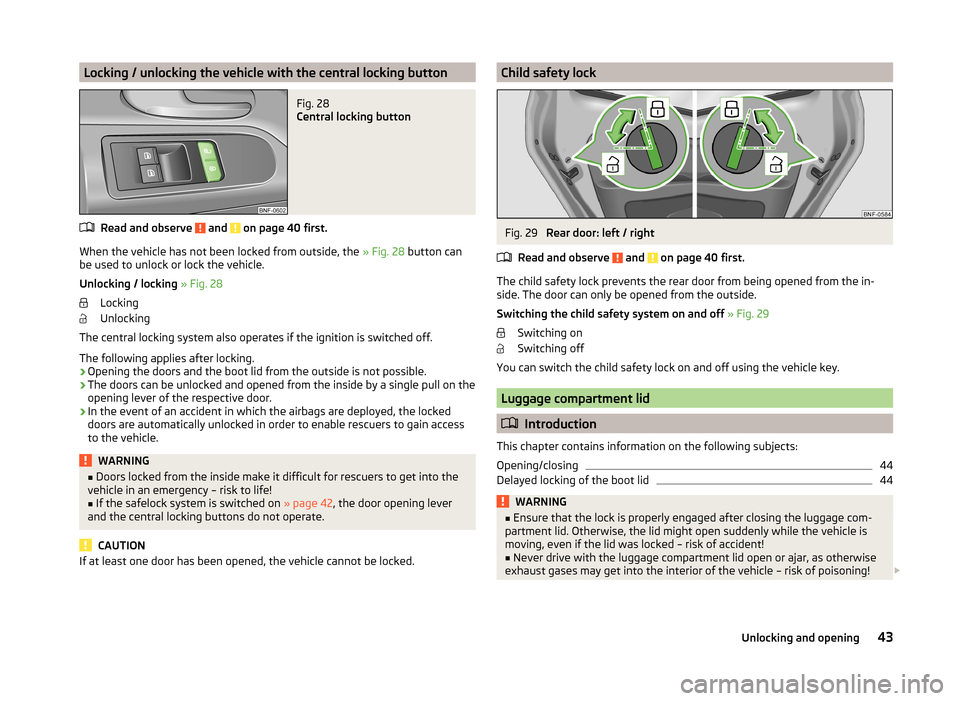
Locking / unlocking the vehicle with the central locking buttonFig. 28
Central locking button
Read and observe and on page 40 first.
When the vehicle has not been locked from outside, the » Fig. 28 button can
be used to unlock or lock the vehicle.
Unlocking / locking » Fig. 28
Locking
Unlocking
The central locking system also operates if the ignition is switched off.
The following applies after locking.
› Opening the doors and the boot lid from the outside is not possible.
› The doors can be unlocked and opened from the inside by a single pull on the
opening lever of the respective door.
› In the event of an accident in which the airbags are deployed, the locked
doors are automatically unlocked in order to enable rescuers to gain access
to the vehicle.
WARNING■ Doors locked from the inside make it difficult for rescuers to get into the
vehicle in an emergency – risk to life!■
If the safelock system is switched on » page 42, the door opening lever
and the central locking buttons do not operate.
CAUTION
If at least one door has been opened, the vehicle cannot be locked.Child safety lockFig. 29
Rear door: left / right
Read and observe
and on page 40 first.
The child safety lock prevents the rear door from being opened from the in- side. The door can only be opened from the outside.
Switching the child safety system on and off » Fig. 29
Switching on
Switching off
You can switch the child safety lock on and off using the vehicle key.
Luggage compartment lid
Introduction
This chapter contains information on the following subjects:
Opening/closing
44
Delayed locking of the boot lid
44WARNING■ Ensure that the lock is properly engaged after closing the luggage com-
partment lid. Otherwise, the lid might open suddenly while the vehicle is
moving, even if the lid was locked – risk of accident!■
Never drive with the luggage compartment lid open or ajar, as otherwise
exhaust gases may get into the interior of the vehicle – risk of poisoning!
43Unlocking and opening
Page 47 of 164

WARNING (Continued)■Do not press on the rear window when closing the luggage compartment
lid, as otherwise this could crack – risk of injury!■
Make sure that when closing the boot lid, no body parts are crushed -
there is danger of injury!
Note
The function of the button in the grip above the licence plate is deactivated
when starting off or at a speed of 9 km/hour or more for vehicles with central
locking. The function is restored after the vehicle stops and the door is
opened.
Opening/closing
Fig. 30
Luggage compartment lid
Read and observe
on page 43 first.
Unlocking in vehicles without remote control
›
Unlock the driver's door with the vehicle key » page 40.
Unlocking in vehicles with remote control
›
Press the symbol button
in the vehicle key.
Unlocking with the remote control key
›
Press the symbol button
in the vehicle key until the luggage compart-
ment lid is unlocked.
Opening
›
Open the luggage compartment lid by pressing the » Fig. 30 -
button.
Closing›Reach into the recesses » Fig. 30 - and pull the luggage compartment lid
down.›
Close the lid with a slight swing.
Delayed locking of the boot lid
Read and observe
on page 43 first.
If the boot lid is unlocked with the symbol button
on the remote control
key, then the door is automatically locked after closing.
The period after which the boot lid is locked automatically can be extended by a specialist garage.
After activation of delayed locking, the boot lid can be opened again after clos-
ing within a limited period.
Delayed locking can be deactivated by a specialist garage at any time.
CAUTION
There is a risk of unwanted entry into the vehicle before the boot lid is locked
automatically. We therefore recommend locking the vehicle with the symbol
button
on the remote control key.
Electric Windows
Introduction
This chapter contains information on the following subjects:
Open / close windows
45
Manually opening/closing rear windows
45
The electrical power windows can only be operated when the ignition is
switched on.
WARNING■ Ensure that no persons are still left in the vehicle when locking the vehi-
cle. In an emergency, the windows will no longer be able to be opened from
the inside.■
When closing the windows, proceed with caution so as to avoid causing
crushing injuries - risk of injury!
44Using the system
Page 48 of 164
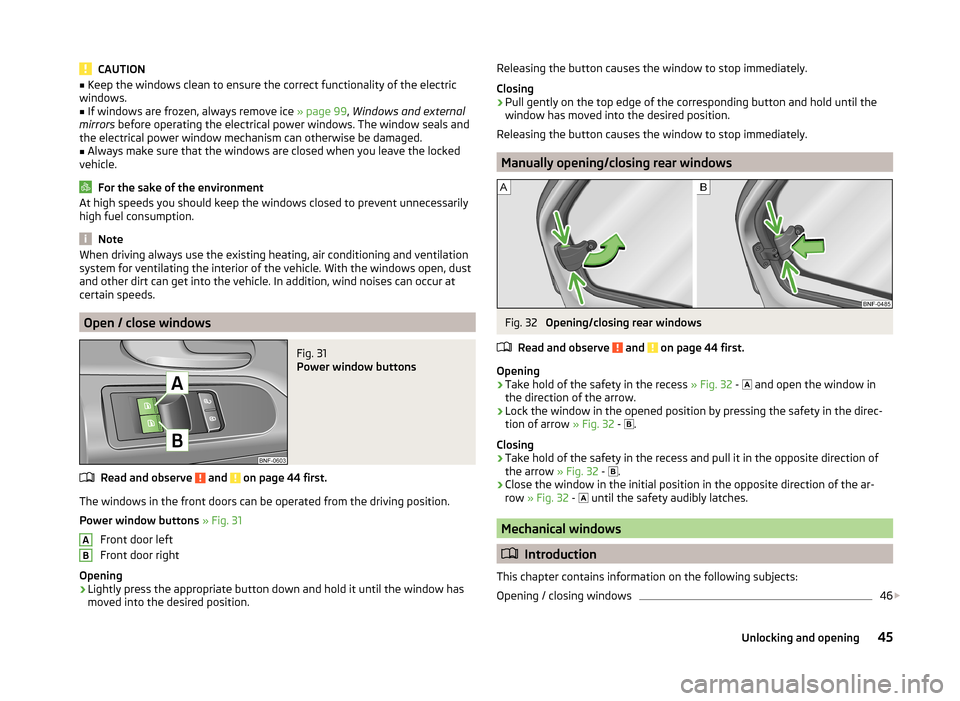
CAUTION■Keep the windows clean to ensure the correct functionality of the electric
windows.■
If windows are frozen, always remove ice » page 99, Windows and external
mirrors before operating the electrical power windows. The window seals and
the electrical power window mechanism can otherwise be damaged.
■
Always make sure that the windows are closed when you leave the locked
vehicle.
For the sake of the environment
At high speeds you should keep the windows closed to prevent unnecessarily high fuel consumption.
Note
When driving always use the existing heating, air conditioning and ventilation
system for ventilating the interior of the vehicle. With the windows open, dust
and other dirt can get into the vehicle. In addition, wind noises can occur at
certain speeds.
Open / close windows
Fig. 31
Power window buttons
Read and observe and on page 44 first.
The windows in the front doors can be operated from the driving position.
Power window buttons » Fig. 31
Front door left
Front door right
Opening
›
Lightly press the appropriate button down and hold it until the window has
moved into the desired position.
ABReleasing the button causes the window to stop immediately.
Closing›
Pull gently on the top edge of the corresponding button and hold until the
window has moved into the desired position.
Releasing the button causes the window to stop immediately.
Manually opening/closing rear windows
Fig. 32
Opening/closing rear windows
Read and observe
and on page 44 first.
Opening
›
Take hold of the safety in the recess » Fig. 32 -
and open the window in
the direction of the arrow.
›
Lock the window in the opened position by pressing the safety in the direc-
tion of arrow » Fig. 32 -
.
Closing
›
Take hold of the safety in the recess and pull it in the opposite direction of
the arrow » Fig. 32 -
.
›
Close the window in the initial position in the opposite direction of the ar-
row » Fig. 32 -
until the safety audibly latches.
Mechanical windows
Introduction
This chapter contains information on the following subjects:
Opening / closing windows
46
45Unlocking and opening
Page 49 of 164
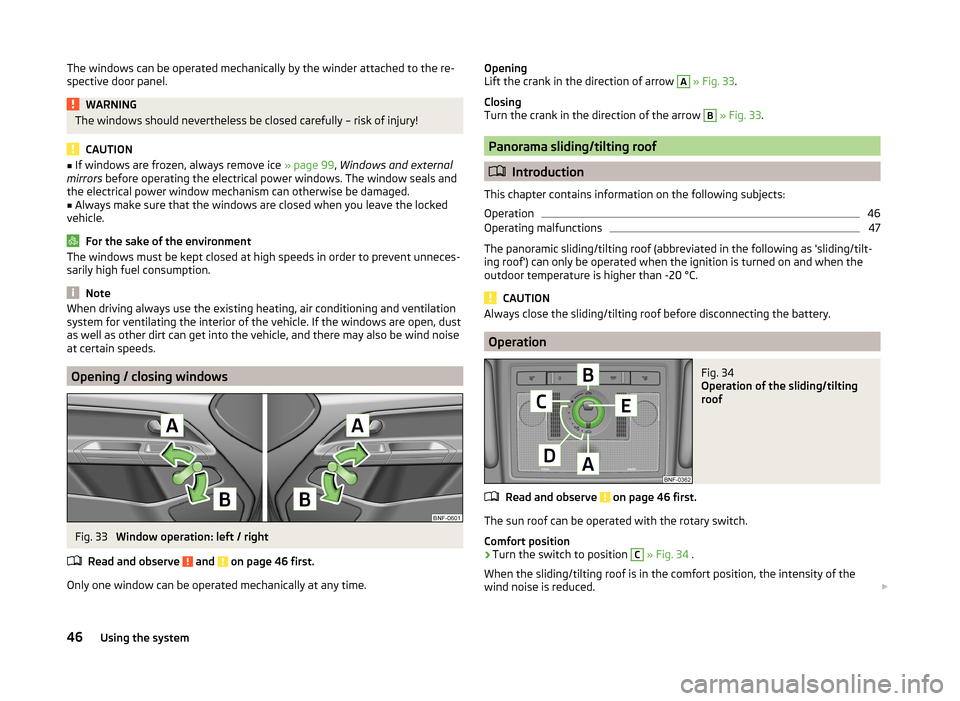
The windows can be operated mechanically by the winder attached to the re-
spective door panel.WARNINGThe windows should nevertheless be closed carefully – risk of injury!
CAUTION
■ If windows are frozen, always remove ice » page 99, Windows and external
mirrors before operating the electrical power windows. The window seals and
the electrical power window mechanism can otherwise be damaged.■
Always make sure that the windows are closed when you leave the locked
vehicle.
For the sake of the environment
The windows must be kept closed at high speeds in order to prevent unneces-
sarily high fuel consumption.
Note
When driving always use the existing heating, air conditioning and ventilation
system for ventilating the interior of the vehicle. If the windows are open, dust
as well as other dirt can get into the vehicle, and there may also be wind noise
at certain speeds.
Opening / closing windows
Fig. 33
Window operation: left / right
Read and observe
and on page 46 first.
Only one window can be operated mechanically at any time.
Opening
Lift the crank in the direction of arrow A » Fig. 33 .
Closing
Turn the crank in the direction of the arrow B
» Fig. 33 .
Panorama sliding/tilting roof
Introduction
This chapter contains information on the following subjects:
Operation
46
Operating malfunctions
47
The panoramic sliding/tilting roof (abbreviated in the following as 'sliding/tilt-
ing roof') can only be operated when the ignition is turned on and when the
outdoor temperature is higher than -20 °C.
CAUTION
Always close the sliding/tilting roof before disconnecting the battery.
Operation
Fig. 34
Operation of the sliding/tilting
roof
Read and observe on page 46 first.
The sun roof can be operated with the rotary switch.
Comfort position
›
Turn the switch to position
C
» Fig. 34 .
When the sliding/tilting roof is in the comfort position, the intensity of the
wind noise is reduced.
46Using the system
Page 50 of 164
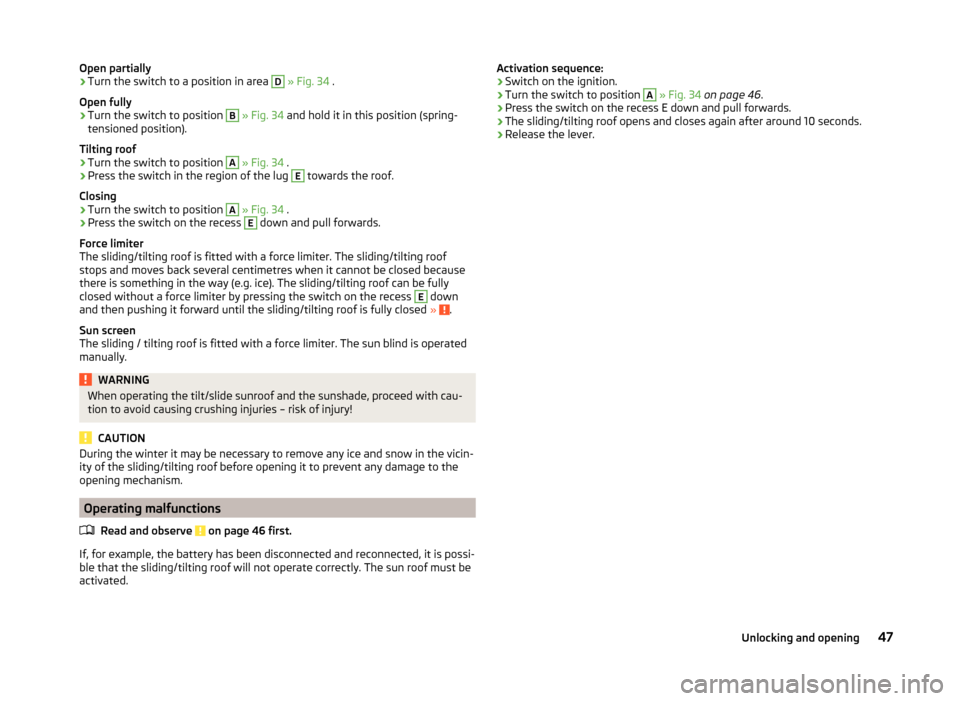
Open partially›Turn the switch to a position in area D » Fig. 34 .
Open fully›
Turn the switch to position
B
» Fig. 34 and hold it in this position (spring-
tensioned position).
Tilting roof
›
Turn the switch to position
A
» Fig. 34 .
›
Press the switch in the region of the lug
E
towards the roof.
Closing
›
Turn the switch to position
A
» Fig. 34 .
›
Press the switch on the recess
E
down and pull forwards.
Force limiter
The sliding/tilting roof is fitted with a force limiter. The sliding/tilting roof
stops and moves back several centimetres when it cannot be closed because
there is something in the way (e.g. ice). The sliding/tilting roof can be fully
closed without a force limiter by pressing the switch on the recess
E
down
and then pushing it forward until the sliding/tilting roof is fully closed » .
Sun screen
The sliding / tilting roof is fitted with a force limiter. The sun blind is operated
manually.
WARNINGWhen operating the tilt/slide sunroof and the sunshade, proceed with cau-
tion to avoid causing crushing injuries – risk of injury!
CAUTION
During the winter it may be necessary to remove any ice and snow in the vicin-
ity of the sliding/tilting roof before opening it to prevent any damage to the
opening mechanism.
Operating malfunctions
Read and observe
on page 46 first.
If, for example, the battery has been disconnected and reconnected, it is possi-ble that the sliding/tilting roof will not operate correctly. The sun roof must be
activated.
Activation sequence:
› Switch on the ignition.
› Turn the switch to position A
» Fig. 34 on page 46 .
› Press the switch on the recess E down and pull forwards.
› The sliding/tilting roof opens and closes again after around 10 seconds.
› Release the lever.
47Unlocking and opening